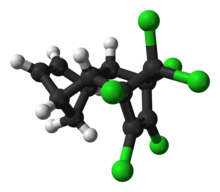Aldrin
Aldrin is an insecticide, which was used against termites, locusts and the larvae of Click beetles. Most plants and animals convert it to Dieldrin. It is listed in the Stockholm Convention on Persistent Organic Pollutants, its production, use and trade are banned since 2004. Aldrin is a neurotoxin. People inhaling it can develop headaches, but also seizures. In humans, Aldrin is converted to dieldrin in the liver. The change will mean that it can leave the body again. The problem is that the change is slow, and the half-life is about a year. Aldrin may be a teratogen, and it probably causes cancer.

| ||

| ||
| Names | ||
|---|---|---|
| IUPAC name
1,2,3,4,10,10-Hexachloro-
| ||
| Other names | ||
| Identifiers | ||
3D model (JSmol)
|
||
| ChEBI | ||
| ChEMBL | ||
| ChemSpider | ||
| ECHA InfoCard | 100.005.652 | |
| EC Number |
| |
| KEGG | ||
PubChem CID
|
||
| RTECS number |
| |
| UNII | ||
| UN number | 2762, 2761 | |
CompTox Dashboard (EPA)
|
||
| ||
| Properties | ||
| C12H8Cl6 | ||
| Molar mass | 364.90 g·mol−1 | |
| Appearance | colorless solid | |
| Density | 1.60 g/mL[1] | |
| Melting point | 104 °C (219 °F; 377 K) | |
| slightly soluble (0.003%)[1] | ||
| Vapor pressure | 7.5 × 10−5 mmHg @ 20 °C | |
| Hazards | ||
| Main hazards | potential occupational carcinogen[1] | |
| NFPA 704 |
| |
| U.S. Permissible exposure limit (PEL) |
TWA 0.25 mg/m3 [skin][1] | |
Except where otherwise noted, data are given for materials in their standard state (at 25 °C [77 °F], 100 kPa). | ||
| Infobox references | ||
Production
changeAldrin is produced by combining hexachlorocyclopentadiene with norbornadiene in a Diels-Alder reaction to give the adduct.[2]
Aldrin is named after the German chemist Kurt Alder, one of the coinventors of this kind of reaction. An estimated 270 million kilograms of aldrin and related cyclodiene pesticides were produced between 1946 and 1976.
In soil, on plant surfaces, or in the digestive tracts of insects, aldrin oxidizes to the epoxide, dieldrin. Dieldrin is more strongly insecticidal than aldrin.
References
change- ↑ 1.0 1.1 1.2 1.3 1.4 1.5 NIOSH Pocket Guide to Chemical Hazards. "#0016". National Institute for Occupational Safety and Health (NIOSH).
- ↑ Jubb, A. H. (1975). Basic Organic Chemistry, Part 5 Industrial products. London: Wiley. ISBN 0-471-85014-4.
